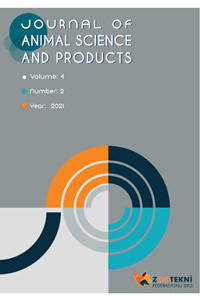Research Article
Issue Editorial Board


İbrahim Cemal, 1988 yılında Yüzüncü Yıl Üniversitesi Ziraat Fakültesi Zootekni Bölümünde başladığı Lisans eğitimini 1992 yılında dereceyle tamamlamıştır. Van Yüzüncü Yıl Üniversitesi’nde Yüksek Lisans çalışmasına 1994 yılında başlamış ve “Çiftlik Hayvanlarında Major Genler: Bunların Belirlenmesi, Transferi ve Endüstriyel Kullanımı” isimli tez çalışmasını 1996 yılında tamamlamıştır. Yüksek Lisans tez çalışmasını yürüttüğü 1994-1996 yıllarını kapsayan süreçte Yüzüncü Yıl Üniversitesi Ziraat Fakültesi Zootekni Bölümünde Araştırma Görevlisi olarak çalışmıştır. Aydın Adnan Menderes Üniversitesi Çine Meslek Yüksekokulunda açılan Uzman kadrosuna 1996 yılında atanmıştır. Aydın Adnan Menderes Üniversitesinde 1996 yılında başladığı “Kantitatif Karakterlerde Major Gen Etki Biçimlerinin Parametre Tahminlerinde Ortaya Koyacağı Değişiklikler” isimli doktora tez çalışmasını ise 2001 yılında tamamlamıştır. Çine Meslek Yüksekokulunda 1998 yılında Öğretim Görevlisi kadrosuna atanan aday aynı yıl Aydın Adnan Menderes Üniversitesi Ziraat Fakültesi Zootekni Bölümü Biyometri ve Genetik Anabilim Dalında açılan Araştırma Görevlisi kadrosuna atanmıştır. Ardından, aynı anabilim dalında açılan Yardımcı Doçent kadrosuna 2003 yılında atanmış, 2008 yılında Doçentlik unvanı almış ve ardından aynı yıl Doçent kadrosuna atanmıştır. Profesör kadrosuna 2013 yılında atanan İbrahim CEMAL, halen Aydın Adnan Menderes Üniversitesi Ziraat Fakültesi Zootekni Bölümü Biyometri ve Genetik Anabilim Dalı’nda Profesör kadrosunda görev yapmaktadır. Şu anda, Biyometri ve Genetik Anabilim Dalı'nın Başkanlığı görevi yanında Zootekni Bölüm Başkanlığı ve Aydın Adnan Menderes Üniversitesi Tarımsal Biyoteknoloji ve Gıda Güvenliği Uygulama ve Araştırma Merkezi (TARBİYOMER) Müdürlüğü görevlerini yürütmektedir. Evli ve 2 çocuk babasıdır.



Aim & Scope
Journal of Animal Science and Products (JASP) is publish 2 times a year and an international peer-reviewed open access journal publishing original scientific papers and reviews on animal science, animal production and related areas. The JASP journal welcomes innovative and novel science that relates to farmed, wild or experimental animals for animal production, and animal management practices and/or that is relevant to animal products. Manuscripts can be accepted from all animal species in which they contribute knowledge about animal production systems. JASP journal provides crucial reading for all animal scientists, stakeholders and policy makers interested in agricultural, veterinary, life sciences and food science with expected impacts on Animal Husbandry and Nutrition, Animal Genetics and Breeding, Animal Health, Animal Welfare and Behaviour, Farm Animal Biology, and Sustainability of Animal Agriculture and Livestock Systems.
Journal of Animal Science and Products (JASP) is established within the scope and responsibility of Turkish Federation of Animal Science.
Journal of Animal Science and Products is published 2 times a year (ISSN: 2667-4580). Its short name is JASP. The scope of the journal covers all aspects of animal science and production.
Journal of Animal Science and Products is an open access and an international journal. All issues are freely available without any charge for either user or institution. Users are allowed to read, download, copy, distribute, print, search, or link to the full texts of the articles, or use them for any other lawful purpose, without asking prior permission from the publisher or the author.
The journal publishes original research articles, short communications, scientific reports, case reports, technical notes, letters to the editor, reviews, and, when necessary, research and conference books.
Author Guidelines
Ethical Principles and Publication Policy
Ethical Principles and Publication Policy
Journal of Animal Science and Products (JASP) is a journal that strives to reach the highest publishing ethics standards and also considers the following Publication Ethics Principles.
Ethical responsibilities of editors and associate editors
Ethical responsibilities of referees
Ethical responsibilities of authors
1. Articles sent to Journal of Animal Science and Products (JASP) must be original studies that are suitable for the scopes of the journal.
2. Authors cannot send their articles sent for publication to another journal at the same time.
3. Authors should collect data on their study within the framework of ethical principles. If the raw data that forms the basis of the study are requested, the authors are obliged to forward it to the publisher, editor, and referees.
4. Articles submitted for publication should not be contrary to scientific publication ethics (plagiarism, forgery, distortion, republishing, slicing, unfair authorship, not specifying the supporting organization, not complying with ethical rules in studies on animals).
5. Studies submitted to the journal should contain sufficient reference information and detail. Fraudulent and deliberate false statements are unacceptable as they will lead to unethical situations. Theses or studies that have not yet been presented or defended cannot be used as sources without the permission of the owner.
6. Potential conflicts of interest of the authors should be stated. Authors are obliged to declare the organizations, financial resources or conflicts of interest that support the studies they submit.
7. Each person who contributed to the design, implementation, or interpretation of the study submitted to the journal should be cited in the study. All major contributors should be listed following the first author. Other supporters can be mentioned in the "Acknowledgements" section of the study.
8. During the publication process, the "Corresponding Author" who corresponds with the relevant journal/institution is accepted. The corresponding author should share his correspondence with other authors and take the necessary actions in a timely and accurate manner.
9. If the author detects a significant error or defect in his published work in the journal, he is obliged to immediately notify the journal editor or the publisher and cooperate with the editor to correct the existing error or defect.
10. It is accepted that all authors take responsibility for the content of the article. It is unethical for a person who does not contribute to an article to be an author. Likewise, it is unethical not to include someone who has made a significant contribution to the publication among the authors.
Actions Contrary to Scientific Research and Publication Ethics
Price Policy
The articles sent to our journal are evaluated free of charge and the articles deemed worthy of publication are published free of charge.
Journal Boards
Owner

Editor in Chief

Associate Editor

Editorial Board





Statistics Editor

English Editor

Secretary


Dr. Öğr. Üyesi Emre UĞURLUTEPE
Indexed by:







